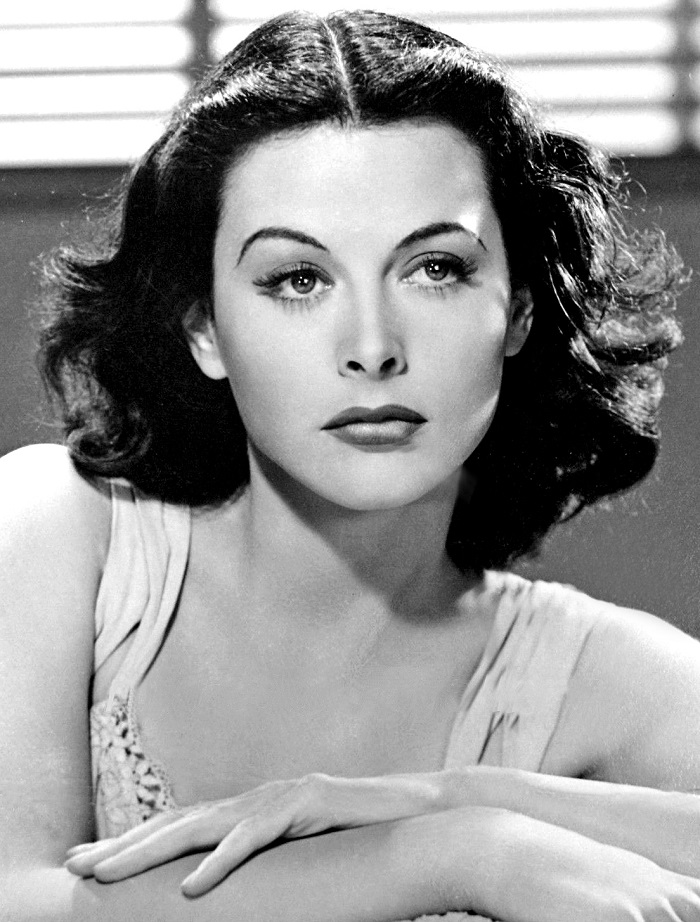Bombshell: The Hedy Lamarr Story review - Hollywood's brainiest beauty | reviews, news & interviews
Bombshell: The Hedy Lamarr Story review - Hollywood's brainiest beauty
Bombshell: The Hedy Lamarr Story review - Hollywood's brainiest beauty
Belated homage to the Austrian film star with a scientific hinterland

Hedy Lamarr really ought to be the poster girl for the Time's Up movement. “Any girl can look glamorous," she once said. "All she has to do is stand still and look stupid.” She was the model for Catwoman and Disney's Snow White. It's less well known that she patented an invention which led to the creation of Bluetooth and Wi-Fi. If she were alive now, she might be sitting on a £30 billion dollar fortune.
That capacious narrative has been crammed into a 90-minute documentary: Bombshell: The Hedy Lamarr Story. The title is a witty double entendre. Hedy Lamarr – born Hedwig Kiesler – was indeed a bombshell, if not a conventionally blonde one. “I never knew I looked good to begin with,” she said. As a child, enthused by her father, she developed a nerdy fascination for how things worked. But in her teens she noticed her burgeoning power to reduce Viennese men to pulp. She commissioned a nude photograph of herself at 16. In her screen debut, for Sascha Film Studios, she spoke shrilly in German while wearing a contour-hugging swimsuit. Then, cast at 19 in Ecstasy (1933), she became the first woman in the history of non-pornography to appear naked on the big screen, and fake a flagrant orgasm to boot. That got a lot of men’s attention, including the Pope, Hitler and Louis B Mayer.
But there was the other side of Lamarr. In the early skirmishes of the Second World War, when the U-boats bossed the Atlantic, she came up with an ingenious design for radio-controlled torpedoes which could not be detected by the enemy. After got it patented, the US Navy told her she’d be more useful if she deployed her stardom to sell war bonds. Her beauty was an asset. Her brains were disregarded. They later used the idea anyway, without telling her, which helps explain why this half of her story is still not widely understood. “I heard that she is a scientist,” says Mel Brooks, who yearned to marry her or at least grope her under the table. “So is this true?”
 The face – heart-shaped under a fashion-setting centre parting, with a gigawatt smile and hooded, angled eyes that seemed to know things – was ravishing. And Lamarr had the intelligence to make the most of it. Such was the impact of Ecstasy that her first husband, a rich Austrian munitions manufacturer, jealously bought up extant images as fast as they could be printed. Eventually his wife escaped to London. Mayer was signing European talent on the cheap and didn’t meet this young Austrian woman’s valuation of herself – which she couldn't communicate in English, as she didn't yet speak it. So as they crossed the Atlantic, she shrewdly made an exhibition of herself before an awestruck Douglas Fairbanks Jnr, and Mayer upped his offer. By the time she disembarked in New York, she had been given a new surname which made her sound like a mythical creature of the deep.
The face – heart-shaped under a fashion-setting centre parting, with a gigawatt smile and hooded, angled eyes that seemed to know things – was ravishing. And Lamarr had the intelligence to make the most of it. Such was the impact of Ecstasy that her first husband, a rich Austrian munitions manufacturer, jealously bought up extant images as fast as they could be printed. Eventually his wife escaped to London. Mayer was signing European talent on the cheap and didn’t meet this young Austrian woman’s valuation of herself – which she couldn't communicate in English, as she didn't yet speak it. So as they crossed the Atlantic, she shrewdly made an exhibition of herself before an awestruck Douglas Fairbanks Jnr, and Mayer upped his offer. By the time she disembarked in New York, she had been given a new surname which made her sound like a mythical creature of the deep.
Hedy Lamarr had a good year in 1940, starring alongside Judy Garland, Clark Gable and James Stewart. But while cinematographers knew how to light that face, she didn’t get the better scripts. From Algiers (1938) to Cecil B. de Mille’s Samson and Delilah (1949), there isn’t anything in Lamarr’s filmography to rival the other female stars who came over from the old continent. Marlene, Greta and Ingrid all left a much deeper imprint as actresses. But how many of them told Howard Hughes precisely how to streamline his plane to make it go faster? “I thought the airplanes were too slow,” she recalled. “They shouldn’t be square.”
She was a resourceful fabricator. Among her pragmatic fibs was to tell the gossip columnist Hedda Hopper she’d been forced by a wicked European director to go nude in Ecstasy. She also denied her Judaism to her children. The film addresses the possibility that the frequency hopping system wasn’t Lamarr’s idea, that she’d overheard it at the dinner table of her first husband. But it comes to the conclusion that she really did come up with the goods herself.
As marshalled by director Alexandra Dean, Bombshell is the revelatory memoir Lamarr never published. Her voice is threaded through the story courtesy of the recently discovered cassette tapes of a phone interview she gave to Fleming Meeks, a Forbes Magazine journalist, in 1990. Her reminiscences link the disparate elements of her life, from childhood in Vienna for which she clearly had a burning nostalgia, through the saga of the half-dozen mostly older husbands. It doesn't take a shrink to guess that they were mostly poor substitutes for her much missed father. She had children by only one of them, and both clearly adore her memory while understanding that hers was a multifaceted psychology. As she said on The Merv Griffin Show in 1969, “I am a very simple complicated person." (The full clip is on YouTube.)
The complexity was written into that famous face on which, as it aged, she wrought hideous damage in botched surgeries and fruitless corrections. Lamarr became a recluse who refused even to see her children. By the end, it was as if the face had itself been torpedoed.
The future of Arts Journalism
You can stop theartsdesk.com closing!
We urgently need financing to survive. Our fundraising drive has thus far raised £49,000 but we need to reach £100,000 or we will be forced to close. Please contribute here: https://gofund.me/c3f6033d
And if you can forward this information to anyone who might assist, we’d be grateful.

Subscribe to theartsdesk.com
Thank you for continuing to read our work on theartsdesk.com. For unlimited access to every article in its entirety, including our archive of more than 15,000 pieces, we're asking for £5 per month or £40 per year. We feel it's a very good deal, and hope you do too.
To take a subscription now simply click here.
And if you're looking for that extra gift for a friend or family member, why not treat them to a theartsdesk.com gift subscription?
more Film
 The Courageous review - Ophélia Kolb excels as a single mother on the edge
Jasmin Gordon's directorial debut features strong performances but leaves too much unexplained
The Courageous review - Ophélia Kolb excels as a single mother on the edge
Jasmin Gordon's directorial debut features strong performances but leaves too much unexplained
 Blu-ray: The Graduate
Post #MeToo, can Mike Nichols' second feature still lay claim to Classic Film status?
Blu-ray: The Graduate
Post #MeToo, can Mike Nichols' second feature still lay claim to Classic Film status?
 Little Trouble Girls review - masterful debut breathes new life into a girl's sexual awakening
Urska Dukic's study of a confused Catholic teenager is exquisitely realised
Little Trouble Girls review - masterful debut breathes new life into a girl's sexual awakening
Urska Dukic's study of a confused Catholic teenager is exquisitely realised
 Young Mothers review - the Dardennes explore teenage motherhood in compelling drama
Life after birth: five young mothers in Liège struggle to provide for their babies
Young Mothers review - the Dardennes explore teenage motherhood in compelling drama
Life after birth: five young mothers in Liège struggle to provide for their babies
 Blu-ray: Finis Terrae
Bleak but compelling semi-documentary, filmed on location in Brittany
Blu-ray: Finis Terrae
Bleak but compelling semi-documentary, filmed on location in Brittany
 Oslo Stories Trilogy: Sex review - sexual identity slips, hurts and heals
A quietly visionary series concludes with two chimney sweeps' awkward sexual liberation
Oslo Stories Trilogy: Sex review - sexual identity slips, hurts and heals
A quietly visionary series concludes with two chimney sweeps' awkward sexual liberation
 Sorry, Baby review - the healing power of friendship in the aftermath of sexual assault
Eva Victor writes, directs and stars in their endearing debut feature
Sorry, Baby review - the healing power of friendship in the aftermath of sexual assault
Eva Victor writes, directs and stars in their endearing debut feature
 Blu-ray: Who Wants to Kill Jessie?
Fast-paced and visually inventive Czech comedy
Blu-ray: Who Wants to Kill Jessie?
Fast-paced and visually inventive Czech comedy
 Oslo Stories Trilogy: Love review - freed love
Gay cruising offers straight female lessons in a heady ode to urban connection
Oslo Stories Trilogy: Love review - freed love
Gay cruising offers straight female lessons in a heady ode to urban connection
 Beating Hearts review - kiss kiss, slam slam
Romance and clobberings in a so-so French melodrama
Beating Hearts review - kiss kiss, slam slam
Romance and clobberings in a so-so French melodrama
 Materialists review - a misfiring romcom or an undercooked satire?
Writer-director Celine Song's latest can't decide what kind of film it is
Materialists review - a misfiring romcom or an undercooked satire?
Writer-director Celine Song's latest can't decide what kind of film it is

Add comment